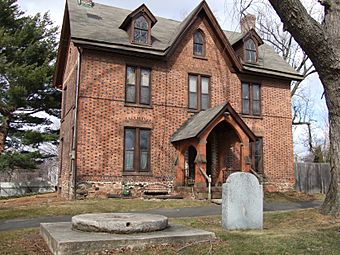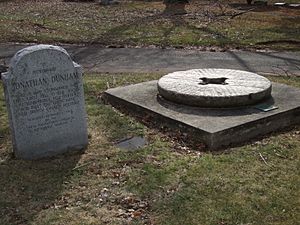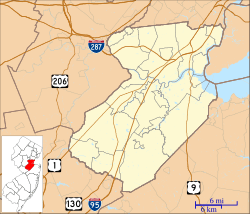Jonathan Singletary Dunham House facts for kids
Quick facts for kids |
|
|
Jonathn Singletary Dunham House
|
|
|
U.S. Historic district
Contributing property |
|

Jonathan Dunham House and mill site
|
|
| Location | 650 Rahway Avenue, Woodbridge Township, New Jersey |
|---|---|
| Built | ca. 1700 |
| Architectural style | Gothic Revival, Colonial Revival |
| Part of | Trinity Episcopal Church (ID04000431) |
| Added to NRHP | May 12, 2004 |
The Jonathan Singletary Dunham House is a very old home in Woodbridge Township, New Jersey. It is in Middlesex County, New Jersey, in the United States. This house was built around the year 1700.
It was built by a man named Jonathan Singletary Dunham. He was an early American settler. He also built the very first gristmill in New Jersey. A gristmill is a place where grain is ground into flour.
Jonathan Dunham was born in Newbury, Massachusetts. He later moved to New Jersey with his wife, Mary Bloomfield. Mary was related to Joseph Bloomfield, who became a governor of New Jersey. The town of Bloomfield, New Jersey is named after him. Jonathan Dunham also served in the government. He was elected to the New Jersey Provincial Congress in 1673.
Did you know? Jonathan Singletary Dunham is an ancestor of former President Barack Obama! He is Obama's eighth great-grandfather. He was also the first of Obama's ancestors to be born in North America.
History of the Dunham House

The land for the house and gristmill was given to Jonathan Dunham. It was a large area, about 213 acres (0.86 square kilometers). The Governor of New Jersey gave him this land.
The Dunham House is the oldest building in Woodbridge Township. It is also one of the oldest buildings in all of Middlesex County. When it was first built, it had two stories and four rooms. The bricks used to build it came all the way from Holland! These bricks were used as heavy ballast in ships.
The house has a special brick pattern called "Flemish bond." This pattern looks like a checkerboard. You can see it clearly on the front of the house. During the American Revolution, American soldiers used the house as a garrison. This means it was a place where soldiers stayed and protected the area.
The gristmill was a special kind of mill called a "tidal mill." This means it used the power of the tides to grind grain. It was located near the house, along the Woodbridge River. This river was once known as Papiack Creek.
The Dunham House Today
Since 1873, the Jonathan Singletary Dunham House has been part of the Trinity Episcopal Church. This church is listed on both the New Jersey and national lists of historic places.
Jonathan's youngest son, Benjamin Dunham, helped start this church. Today, the house his father built is used as the Rectory. This is where the church's priest lives.
You can still see one of the original round millstones from Dunham's gristmill. It is displayed right on the property. It's a cool piece of history!




